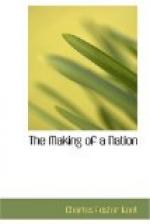Even more definitely established is the so-called theory of evolution which is based on the careful observation and comparison of countless thousands of natural phenomena. According to the Encyclopedia Britannica it is the history of the physical process by which all living beings have acquired the characteristics, physical, mental, moral, and spiritual, which now distinguish them. It recognizes the gradual development from the simplest to the most complex forms. It is merely an attempt to describe in the light of careful observation and investigation the process of growth by which the world and the beings which inhabit it have grown into what they are.
A comparison of the Hebrew account of creation with those of other races and times is extremely suggestive.
II.
THE PRIESTLY STORY OF CREATION.
Note that the first and second chapters of Genesis contain two distinct accounts of creation.
Read Genesis 1:1—2:3 (see Hist. Bib., I, pp. 231-3 for modern translation), noting its picture of conditions in the universe before the actual work of creation began. The creative power is the spirit or breath of God. The Hebrew word for spirit (ruah) represents the sound of the breath as it emerges from the mouth or the sound of the wind as it sighs through the trees. It is the effective symbol of a real and mighty force that cannot be seen or touched yet produces terrific effects, as when the cyclone rends the forest or transforms the sea into a mountain of billows and twists like straws the masts of wood and steel. In the Old Testament the “spirit of God” or the “spirit of the Holy One” is God working (1) in the material universe, as in the work of creation, (2) in human history, as when he directs the life of nations, or (3) in the lives of men.
Note the method of creation and the distinctive work of each day. The process is that of separation. It is orderly and progressive. The first three days of preparation in which (1) light and darkness, (2) air and water (separated by the firmament) and (3) land and vegetation are created, correspond to the work of the second three days in which are created (1) the heavenly bodies, (2) the birds and fishes (which live in the air and water) and (3) land animals and man. The underlying conception of the universe is that held by most early peoples. Compare the diagram in Hastings’ Dictionary of the Bible I, 503 or Kent’s Student’s Old Testament, Vol. I, p. 52 which illustrates it.
God’s benign plan is revealed by the recurring words: “God saw that it was good.” What was the culminating act of creation? “Created man in his image” can not mean with a body like that of God (for in this story God is thought of as a spirit), but rather with a God-like spirit, mind, will, and power to rule.




